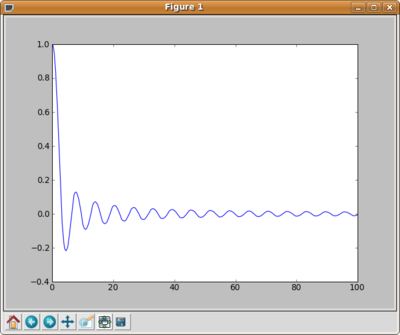How to convert a matplotlib figure to a numpy array or a PIL image
Description
For manipulating a figure build with matplotlib, it is sometimes requested to convert it in a format understandable by other python libraries. This can be useful for using scipy image filters or manually adding annotations for example.Prerequisites
Language- PYTHON >=2.5
- matplotlib >=0.99.0
- numpy >=1.2.1
- PIL (Python Imaging Library) >=0.1.6
import matplotlib.pyplot import numpy # Generate a figure with matplotlib</font> figure = matplotlib.pyplot.figure( ) plot = figure.add_subplot ( 111 ) # draw a cardinal sine plot x = numpy.arange ( 0, 100, 0.1 ) y = numpy.sin ( x ) / x plot.plot ( x, y )
matplotlib.pyplot.show()
1D Plot of a Cardinal Sine, with frame decorations

REM If you obtain an message like :
.../python2.5/lib/python2.5/site-packages/matplotlib/backends/__init__.py:41: UserWarning: Your currently selected backend, 'agg' does not support show(). Please select a GUI backend in your matplotlibrc file
matplotlib.pyplot.savefig ( "./my_img.png" )
import numpy def fig2data ( fig ): """ @brief Convert a Matplotlib figure to a 4D numpy array with RGBA channels and return it @param fig a matplotlib figure @return a numpy 3D array of RGBA values """ # draw the renderer fig.canvas.draw ( ) # Get the RGBA buffer from the figure w,h = fig.canvas.get_width_height() buf = numpy.fromstring ( fig.canvas.tostring_argb(), dtype=numpy.uint8 ) buf.shape = ( w, h,4 ) # canvas.tostring_argb give pixmap in ARGB mode. Roll the ALPHA channel to have it in RGBA mode buf = numpy.roll ( buf, 3, axis = 2 ) return buf
import Image def fig2img ( fig ): """ @brief Convert a Matplotlib figure to a PIL Image in RGBA format and return it @param fig a matplotlib figure @return a Python Imaging Library ( PIL ) image """ # put the figure pixmap into a numpy array buf = fig2data ( fig ) w, h, d = buf.shape return Image.fromstring( "RGBA", ( w ,h ), buf.tostring( ) )
im = fig2img ( figure )
im.show()









